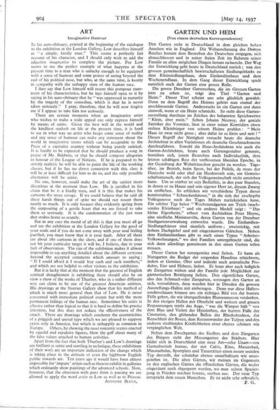ART
Imaginative Humour IN his auto-obituary, printed at the beginning of the catalogue to the exhibition at the London Gallery, Low describes himself as " a simple, kindly man." This seems a perfectly fair account of his character, and I should only wish to add the adjective imaginative to complete the picture. For Low seems to me the perfect example of what happens at the present time to a man who is unlucky enough to be equipped with a sense of humour and some power of seeing beyond the end of his political nose, but who, at the same time, is keenly in sympathy with the unhappy state of the human race.
I dare say that Low himself will resent this pompous state- ment of his characteristics, but he lays himself open to it by saying in his auto-obituary that he " was oppressed in maturity by the tragedy of the comedian, which is that he is never taken seriously." I pray, therefore, that he will now forgive me if I appear to take him too seriously.
There are certain moments when an imaginative artist who wishes to make a wide appeal can only express himself by means of satire. Given the best will in the world and the kindliest outlook on life at the present time, it is hard to see in what way an artist who keeps some sense of reality and any sense of humour can make any statement about the world in imaginative terms which can be acceptable to the Press of a capitalist country without being purely satirical. It is hardly to be expected that he should produce a song in praise of Mr. Baldwin, or that he should compose allegories in honour of the League of Nations. If he is prepared to be strictly realistic he will be able to paint the life of the working classes, but if he has no direct connexion with this class it will be at least difficult for him to do so, and the only possible alternative will be satire.
No one, however, could make the art of the satirist more illustrious at the moment than Low. He is justified in his claim that he is a kindly man, and it is this that makes his cartoons the more savage. If we could believe that he said all these harsh things out of spite we should not resent them nearly so much. It is only because they evidently spring from the outpouring of a gentle heart that we are forced to take them so seriously. It is the condemnation of the just man that strikes home so acutely.
But in any case the moral of all this is that you must all go and sec the exhibition at the London Gallery for the good of your souls and if you do not come away with your soul feeling purified, you must know that it is your fault. After all there are about i8o cartoons in the show, and if one of them does not hit your particular target it will be, I believe, due to your lack of observation. The size of the exhibition makes it almost impossible to say anything detailed about the different cartoons beyond the accepted comments which amount to saying : " If I could afford it I would buy such and such numbcrs," and which are not helpful to other visitors to the exhibition.
But it is lucky that at the moment that the greatest of English satirical draughtsmen is exhibiting there should also be on view a show of the works of Thurber, who in a rather different way can claim to be one of the greatest American satirists. His drawings at the Storran Gallery show that his method of attack is much more general than that of Low. He is never concerned with immediate political events but with the more permanent failings of the human race. Sometimes his satire is allusive rather than logical so that it is hard to define his precise intention, but this does not reduce the effectiveness of the attack. There are drawings which condemn the eccentricities of a priggish and unreal type which we are pleased to suppose exists only in America, but which is unhappily as common in Europe. Others, by showing the most romantic scenes enacted by squalid and repulsive figures, blow the gaff about many of the false values attached to human activities.
Apart from the fact that both Thurber's and Low's drawings are brilliant as satire and startling in technique, these exhibitions of their work are an important indication of the change which is taking place in the attitude of even the highbrow English public towards art. Ten years ago it would have been almost impossible for `impure' artists such as these to exhibit in galleries which ordinarily show paintings of the advanced schools. Now, however, that the obsession with pure form is passing we are allowed to apply the word artist to Low as well as to Picasso.
ANTHONY BLUNT.














































 Previous page
Previous page